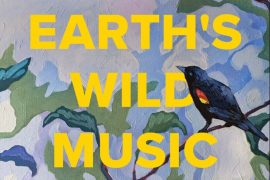“The whole universe is aflame.”
Pierre Teilhard de Chardin, Le Milieu Mystique, (1917)
I
By midafternoon the hawk was ill and by late in the day, she was dying. She had dropped from the sky like a knife-blade, slicing a pigeon’s neck; hungry, she ate but did not finish. Her eyes became as clouded as a winter sky and she did not move from her bough. Ebbing away was a hawk’s life, precarious and beautiful, wings singed with the wild air as they collapsed around her like the tent of night, and from within her, the eggs she would never lay began to die, along with her body’s memory of a soft, feathered mate, the tug and pull of lengthening days, the sun that ladled morning into the bowl of the new-built nest. As time passed and evening fell, her body slowed, then grew as still as a stopped clock.
*
There were witnesses. Others, like myself, read the reports online. We could not turn away, could not escape asking why it matters.
*
The young hawks had made scant attempts to build a nest in the knot of lanes and buildings south of Canal Street in Lower Manhattan, but the she-hawk could feel the first frail egg trying to separate itself from the warm enclosure of her body. Not yet knowing how to protect it, she glided upwards, lighting upon a square metal protrusion where the egg escaped her, then rolled off the a/c unit and smashed on the sidewalk below.
Downward she peered at the accident, lifted her wings, and flew south. There she and her mate, urged onward by the pull of light and lengthening days, began in earnest to weave a nest of twigs and leaves, setting it on another metal cube above the Health Department entrance. They would have mated once again, perhaps in that spectacular dance in which their talons grip at life itself, locking together as the whirlwind seizes them whole.
*
Red-tailed hawks are not sociable creatures. They mate for life, and while both co-operate in the warming of eggs and the nurturing of young, they are for the most part solitary beings. Likewise, falconers’ hawks appear to regard the human arm as a branch, the hand as bearer of food, the keeper’s presence as safety. Apart from these clear demarcations, it is said that raptors cannot relate to us, that they are not wired to understand human touch, that they may regard affection as a threat.
Experience teaches that this truth does not foreclose our mammalian instinct for tenderness, nor does it penetrate the mystery of how the raptor perceives it. Carry one tethered on your gloved fist and you will meet the depth of enormous eyes, cloudlike weight, the span of extravagant wings, an utter strangeness. It is a mystery that even in their fierce enormity, raptors are capable of calling forth the deepest of protective instincts. Yet they are not at all like us.
*
The sombre public building where the downtown hawks built their nest was a quick glide to a small green space — Collect Pond Park, two blocks south of Canal Street. Perhaps the young raptors knew in the spiraling depths of their genes that hawks once glided across centuries to find this place, lighting in an elegant sweep of wing on the ancient Munsee settlement at its southwest border, and maybe the young pair carried in the gravity of nerve and bone the lure of its vanished underground spring, the one that hundreds of years ago quenched the thirst of the settlers of New York. The spring is gone, the park space an austere concrete landscape spiked with pin oak and ailanthus trees bordering a replica pond.
Yet the hawks had found home; perhaps by dead reckoning, as if they bore the contours of the place within their bodies’ memory. In the park they cavorted, found prey to eat, saw smiles on delighted faces, city employees on lunch break with kindly eyes and smartphones raised in blessing.
They had been mating, the two of them, her partner gathering twigs, fortifying their nest, preparing it for a clutch of eggs, while below the female hunted down her fateful prey, then appeared unwell, remaining on her perch for the rest of the day. Too weak to groom or preen, her mouth still bloodied from her toxic meal.
*
There were people who took time to note her fate.
Everyone has a camera now. Everyone bears witness. Yet it is what we choose to see that matters. Also, what we choose to deny.
We do not know why the world unfolds as it does. We do not even know what we know, or when it was we awoke from the sleep of childhood, or how it was that a flame lit the lantern of our body, or how it is that the world is lit by the same extraordinary fire. Only that one day, our eyes began to open.
II
On Easter Sunday in the tenth year of my life, my parents gave me a Brownie Hawkeye camera. I have no idea why. Easter is not a time when we give gifts. Yet from that day onward, my life began to imprint itself on the silver light of film and in the deeper light of the writer’s imagination. Through the camera, the world grew radiant with hope, and, in e e cumming’s words, “the eyes of my eyes (were) opened.” Over sixty years later, equipped with a camera and telephoto lens, I spend my spare time photographing birds. Much of the rest of my life is consumed with writing.
I took joy in that first camera, its exquisite resonance; given on a feast of light, of spring and rebirth.
The date was April 10th, 1955. On that Easter Sunday in New York City — not far from our suburban home — the great Jesuit paleontologist and philosopher Pierre Teilhard de Chardin left this world. Think of ecology, evolution, the sacredness of matter, the spirit indwelling in creation. His thought scrapes the tip of the match, lets loose the flame. By happenstance he closed his eyes just as I was opening the shutter to the light.
For a writer, all things connect. I choose to tell my story in this way because of its metaphoric beauty, and because at the age of ten, I knew with inchoate passion that I was meant to live with open eyes. I wanted to be a photographer then. And I wrote.
*
Here is what happened in Collect Pond Park: In the morning, the male hawk did not understand how it was that his mate was slumped over, talons locked on the branch, one wing collapsed and drooping downward like an avian flag of surrender. Yet not being a creature of thought or word, he was driven by his body’s memory of who she was — and who is to say that this drivenness is not a form of love? And why not ask ourselves if love is as much the raw tug of instinct as it is a cognitive and elevated passion, a generous concept that asks of us a generous use of the word?
The male wanted his mate alive. He tried to rouse her by tugging at her feathers. Then, in confusion, he offered her twigs he’d been collecting for the nest. It took time before he understood that she was gone.
One knew that the gift of instinct would allow this hawk to accept another mate. Yet there are photos of his tender and innocent attempts to rouse his companion, images that evoke a deep and abiding sadness.
It is recorded that bystanders were distressed, that a policeman wept as he took pictures with his phone.
*
A necropsy report stated in clinical but honest language that rodenticide had killed the young hawk. Her demise was unintentional. Yet to grieve her death is to understand what we have lost when we ignore wild parents and their tender young, magnificent nonhuman creatures with spectacular wings and feathers, the dinosaur remnant that holds our ancient days, the clock that tells us where and how we began.
*
It may be that some wept for the hawk because they sensed that we do not have to choose between the suffering of humankind and the pain inflicted on the rest of the living world. In this realization lives an energy, an indivisible bond, the mysterious drive that draws the self into a reality beyond the self, that knows we are formed of clay and bone and the raw energy of love. Perhaps it is that simple.
We dance at the tip of a match.
– End –
Author’s note: I would like to acknowledge the work of Laura Goggin, whose photo blog documented the story of the hawk pair in Lower Manhattan and the female hawk’s death on 31 March 2016.





